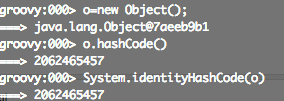碰到一些需求需要放入可重复key的HashMap,比如Excel需要报错的行号。
那么如果对象实现过hashCode方法和equals 那么放入到hashMap中会出现可能互相覆盖的情形。
原来你是这样的HashMap 正如这篇文章中的测试所说,互相覆盖。
那么就是IdentityHashMap出场的时候啦~
首先了解一下Object的hashCode方法
/** * Returns a hash code value for the object. This method is * supported for the benefit of hash tables such as those provided by * {@link java.util.HashMap}. * <p> * The general contract of {@code hashCode} is: * <ul> * <li>Whenever it is invoked on the same object more than once during * an execution of a Java application, the {@code hashCode} method * must consistently return the same integer, provided no information * used in {@code equals} comparisons on the object is modified. * This integer need not remain consistent from one execution of an * application to another execution of the same application. * <li>If two objects are equal according to the {@code equals(Object)} * method, then calling the {@code hashCode} method on each of * the two objects must produce the same integer result. * <li>It is <em>not</em> required that if two objects are unequal * according to the {@link java.lang.Object#equals(java.lang.Object)} * method, then calling the {@code hashCode} method on each of the * two objects must produce distinct integer results. However, the * programmer should be aware that producing distinct integer results * for unequal objects may improve the performance of hash tables. * </ul> * <p> * As much as is reasonably practical, the hashCode method defined by * class {@code Object} does return distinct integers for distinct * objects. (This is typically implemented by converting the internal * address of the object into an integer, but this implementation * technique is not required by the * Java<font size="-2"><sup>TM</sup></font> programming language.) * * @return a hash code value for this object. * @see java.lang.Object#equals(java.lang.Object) * @see java.lang.System#identityHashCode */ public native int hashCode();
文章中提到了java.lang.System#identityHashCode 那么我们看一下这两个数据有没有差别


这里面包含了IntegerCache的相关知识可以各位详细看看Integer的源码

我们可以看出hashCode计算出来(未复写Object)的值和identityHashCode计算出来的相同(估计就是一个值?
/** * Returns the same hash code for the given object as * would be returned by the default method hashCode(), * whether or not the given object's class overrides * hashCode(). * The hash code for the null reference is zero. * * @param x object for which the hashCode is to be calculated * @return the hashCode * @since JDK1.1 */ public static native int identityHashCode(Object x);
bingo~就是和hashCode返回一样【而toString中并不是内存地址而是hashCode的hexString】
/** * Returns a string representation of the object. In general, the * {@code toString} method returns a string that * "textually represents" this object. The result should * be a concise but informative representation that is easy for a * person to read. * It is recommended that all subclasses override this method. * <p> * The {@code toString} method for class {@code Object} * returns a string consisting of the name of the class of which the * object is an instance, the at-sign character `{@code @}', and * the unsigned hexadecimal representation of the hash code of the * object. In other words, this method returns a string equal to the * value of: * <blockquote> * <pre> * getClass().getName() + '@' + Integer.toHexString(hashCode()) * </pre></blockquote> * * @return a string representation of the object. */ public String toString() { return getClass().getName() + "@" + Integer.toHexString(hashCode()); }
那么来看一下IdentityHashMap对应的实现
/** * Constructs a new, empty identity hash map with a default expected * maximum size (21). */ public IdentityHashMap() { init(DEFAULT_CAPACITY); } /** * Constructs a new, empty map with the specified expected maximum size. * Putting more than the expected number of key-value mappings into * the map may cause the internal data structure to grow, which may be * somewhat time-consuming. * * @param expectedMaxSize the expected maximum size of the map * @throws IllegalArgumentException if <tt>expectedMaxSize</tt> is negative */ public IdentityHashMap(int expectedMaxSize) { if (expectedMaxSize < 0) throw new IllegalArgumentException("expectedMaxSize is negative: " + expectedMaxSize); init(capacity(expectedMaxSize)); } /** * Returns the appropriate capacity for the specified expected maximum * size. Returns the smallest power of two between MINIMUM_CAPACITY * and MAXIMUM_CAPACITY, inclusive, that is greater than * (3 * expectedMaxSize)/2, if such a number exists. Otherwise * returns MAXIMUM_CAPACITY. If (3 * expectedMaxSize)/2 is negative, it * is assumed that overflow has occurred, and MAXIMUM_CAPACITY is returned. */ private int capacity(int expectedMaxSize) { // Compute min capacity for expectedMaxSize given a load factor of 2/3 int minCapacity = (3 * expectedMaxSize)/2; // Compute the appropriate capacity int result; if (minCapacity > MAXIMUM_CAPACITY || minCapacity < 0) { result = MAXIMUM_CAPACITY; } else { result = MINIMUM_CAPACITY; while (result < minCapacity) result <<= 1; } return result; } /** * Initializes object to be an empty map with the specified initial * capacity, which is assumed to be a power of two between * MINIMUM_CAPACITY and MAXIMUM_CAPACITY inclusive. */ private void init(int initCapacity) { // assert (initCapacity & -initCapacity) == initCapacity; // power of 2 // assert initCapacity >= MINIMUM_CAPACITY; // assert initCapacity <= MAXIMUM_CAPACITY; threshold = (initCapacity * 2)/3; table = new Object[2 * initCapacity]; }
在传入容量的时候和HashMap不一样 其优先计算了1.5倍 恩 这样不需要开发者考虑expectedSize了
查看其get方法
private static int nextKeyIndex(int i, int len) { return (i + 2 < len ? i + 2 : 0); } /** * Returns the value to which the specified key is mapped, * or {@code null} if this map contains no mapping for the key. * * <p>More formally, if this map contains a mapping from a key * {@code k} to a value {@code v} such that {@code (key == k)}, * then this method returns {@code v}; otherwise it returns * {@code null}. (There can be at most one such mapping.) * * <p>A return value of {@code null} does not <i>necessarily</i> * indicate that the map contains no mapping for the key; it's also * possible that the map explicitly maps the key to {@code null}. * The {@link #containsKey containsKey} operation may be used to * distinguish these two cases. * * @see #put(Object, Object) */ public V get(Object key) { Object k = maskNull(key); Object[] tab = table; int len = tab.length; int i = hash(k, len); while (true) { Object item = tab[i]; if (item == k) return (V) tab[i + 1]; if (item == null) return null; i = nextKeyIndex(i, len); } }
很明显其使用了item==k 其实就是地址的比较
nextKeyIndex这个方法很有意思 看来是用来解决Hash冲突的。hashMap通过链表完成了冲突的解决。{
查看hash方法
/** * Returns index for Object x. */ private static int hash(Object x, int length) { int h = System.identityHashCode(x); // Multiply by -127, and left-shift to use least bit as part of hash return ((h << 1) - (h << 8)) & (length - 1); }
直接调用了System.identityHashCode 并且和tab的length进行了hash【和hashMap类似】
那么IdentityHashMap通过挪后2个位置【下一个位置用来放value】来占位置【某些情境下性能确实很差,但是通过threshold为2/3稍微稀疏了一些】
继续查看put方法
/** * Associates the specified value with the specified key in this identity * hash map. If the map previously contained a mapping for the key, the * old value is replaced. * * @param key the key with which the specified value is to be associated * @param value the value to be associated with the specified key * @return the previous value associated with <tt>key</tt>, or * <tt>null</tt> if there was no mapping for <tt>key</tt>. * (A <tt>null</tt> return can also indicate that the map * previously associated <tt>null</tt> with <tt>key</tt>.) * @see Object#equals(Object) * @see #get(Object) * @see #containsKey(Object) */ public V put(K key, V value) { Object k = maskNull(key); Object[] tab = table; int len = tab.length; int i = hash(k, len); Object item; while ( (item = tab[i]) != null) { if (item == k) { V oldValue = (V) tab[i + 1]; tab[i + 1] = value; return oldValue; } i = nextKeyIndex(i, len); } modCount++; tab[i] = k; tab[i + 1] = value; if (++size >= threshold) resize(len); // len == 2 * current capacity. return null; }
确实可以看到当hash之后发生碰撞直接找到null可以放入为止。
可以看到查找和插入都比较简单。那么如果移除呢
此时需要注意了。因为当前移除的hash可能是后面如果和当前hash一样的需要前移
/** * Removes the mapping for this key from this map if present. * * @param key key whose mapping is to be removed from the map * @return the previous value associated with <tt>key</tt>, or * <tt>null</tt> if there was no mapping for <tt>key</tt>. * (A <tt>null</tt> return can also indicate that the map * previously associated <tt>null</tt> with <tt>key</tt>.) */ public V remove(Object key) { Object k = maskNull(key); Object[] tab = table; int len = tab.length; int i = hash(k, len); while (true) { Object item = tab[i]; if (item == k) { modCount++; size--; V oldValue = (V) tab[i + 1]; tab[i + 1] = null; tab[i] = null; closeDeletion(i); return oldValue; } if (item == null) return null; i = nextKeyIndex(i, len); } }
换言之需要当前的数据之后【循环table到头了需要从0从开始】全部数据需要朝前提两个格子知道查找到为null为止
/** * Rehash all possibly-colliding entries following a * deletion. This preserves the linear-probe * collision properties required by get, put, etc. * * @param d the index of a newly empty deleted slot */ private void closeDeletion(int d) { // Adapted from Knuth Section 6.4 Algorithm R Object[] tab = table; int len = tab.length; // Look for items to swap into newly vacated slot // starting at index immediately following deletion, // and continuing until a null slot is seen, indicating // the end of a run of possibly-colliding keys. Object item; for (int i = nextKeyIndex(d, len); (item = tab[i]) != null; i = nextKeyIndex(i, len) ) { // The following test triggers if the item at slot i (which // hashes to be at slot r) should take the spot vacated by d. // If so, we swap it in, and then continue with d now at the // newly vacated i. This process will terminate when we hit // the null slot at the end of this run. // The test is messy because we are using a circular table. int r = hash(item, len); if ((i < r && (r <= d || d <= i)) || (r <= d && d <= i)) { tab[d] = item; tab[d + 1] = tab[i + 1]; tab[i] = null; tab[i + 1] = null; d = i; } } }
其实key也不重复只是判断“equals”的逻辑发生了变化~




